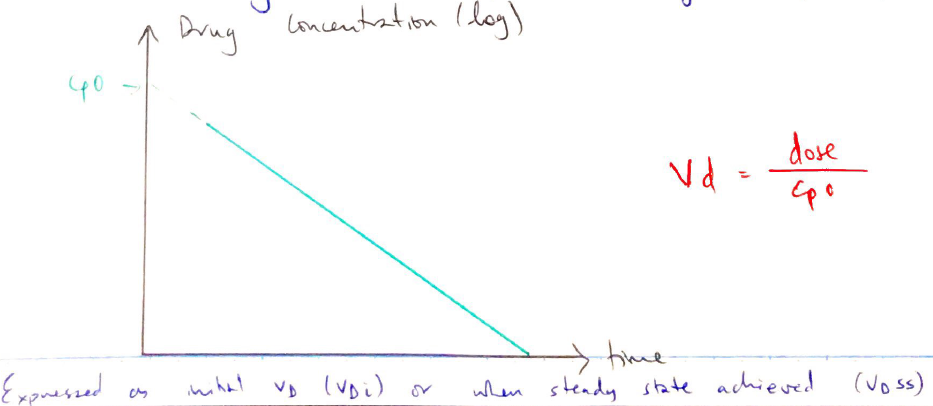19A05: Exam Report
Define volume of distribution (15% of marks). Outline the factors affecting volume of distribution (60% of marks) and explain how it may be measured (25% of marks).
51% of candidates passed this question.
The first two parts of the question were reasonably done. Most candidates had well-structured answers which included drug factors and patient factors. In addition to listing the factors it was expected candidates state how these factors affect volume of distribution. Explaining how volume of distribution is determined was not so well done.
15B12: Exam Report
Define “volume of distribution” and describe the factors that influence it
35% of candidates passed this question.
A definition was required that included reference to plasma concentration, total body content / dose, and the theoretical nature of the volume which can exceed the physical volume of the body.
A broad answer listing patient and drug-related factors was required. Patient factors could include age, gender, muscle mass, fat mass and abnormal fluid distribution (oedema, ascites, pleural effusion). The drug factors would include tissue binding, plasma protein binding and physicochemical properties of drug (size, charge, pKa, lipid solubility, water solubility).
Biii / 19A05 / 15B12: Define volume of distribution (15 marks). Outline the factors affecting volume of distribution (60 marks) and explain how it may be measured (25 marks)
Definition
Vd = the theoretical volume of fluid into which a drug disperses in order to produce the observed plasma [ ]
→ it does NOT correspond with a physiological volume
→ some Vd can be much higher than TBW
- e. body vol 50 – 100L
- VD digoxin 500L
Vd Calculation
- Drug is injected (known dose)
- Blood sample taken immediately to get plasma [ ] at time 0 (before elim starts)
e.g. Dose = 25mg
Plasma Conc t0 = 1mg/L
∴Vd = 25L
- Vd is actually estimated by retro extrapolation of the log Cp vs Time curve
- All the way back to y-axis to get Cp0 (plasma [ ] at time 0)
Factors Affecting VD
Drug Factors
- Molecular size: ↓size = ↑Vd
- Lipid solubility: ↑lipophilicity = ↑Vd
- pKa
- Basic drug → lower pKa = ↑unionised = ↑Vd
- Acidic drug → higher pKa = ↑unionised = ↑Vd
- Charge: ↓charge = ↑Vd
- PPB: ↑ = ↓Vd
Patient Factors
- Blood flow: ↑BF = ↑Vd
- Age: ↑Vd neonates
- TBW: ↓with age = ↓Vd
- ↑fat = ↑Vd lipophilic drugs
- Renal failure, hepatic failure: ↓PPB = ↑Vd
Large Vd
e.g. PPF 5 – 10L/kg
- Much higher [ ] in extravascular tissue cf. vascular compartment
- Lipid soluble drugs
Small Vd
- Drug is polarised
- Restricted to ECF
- e. Vecuronium 0.2L/kg
Very Small Vd
- Drugs super high PPB or highly polarised
- Drug only in vascular compartment
- i. e. Aspirin 0.14L/kg
Calculating Loading Dose
- Clinical relevance of Vd
- Calculate LD for a single IV bolus by multiplying Vd by the desired [ ] at SS
LOADING DOSE = VD x CSS (target plasma concentration)
- Assumption: 1 compartment model
e.g. LD = Vd x target Cp so for digoxin target Cp = 1.5mcg/L
Digoxin Vd = 500L
LD = 500 (L) x 1.5 (mcg/L) = 750mcg
- LD enables SS concentrations to be achieved quickly
